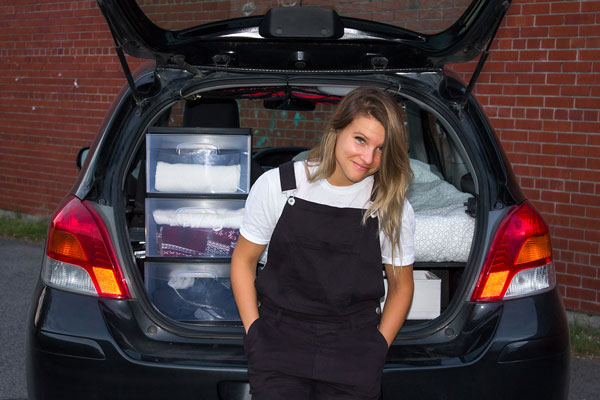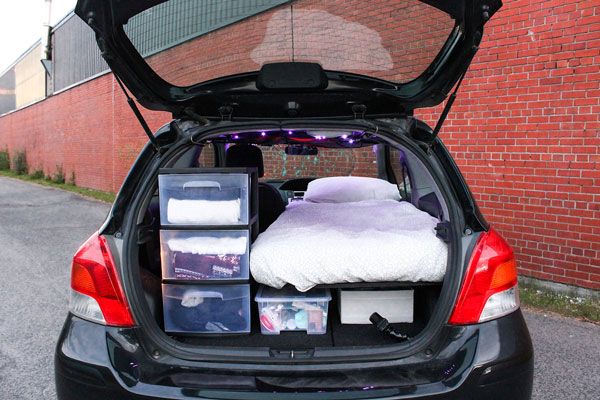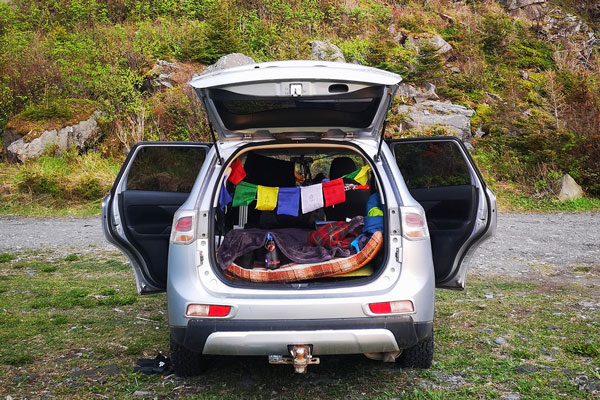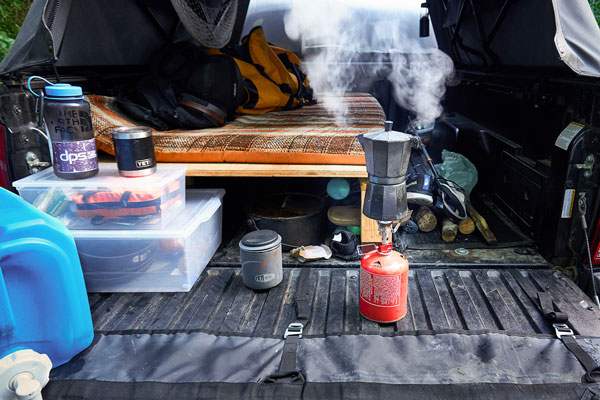The Art of (Great) Car Camping
By Jean-Sébastien Massicotte
What if the key to getting away from it all in the great outdoors for a night—or more—was already dangling from your keychain? What if camping was as easy as jumping into your car? Buckle up, your next adventure could be like no other. Welcome to the world of camping… in your car!
Forget #vanlife and the costly retrofits it requires. You won’t find any spacious, converted vans here; just the simplicity of #carcamping, where your everyday car is your ticket to your next great adventure, where you’ll enjoy life on the road and out in nature in a small space that’s surprisingly efficient and economical.
Take, for instance, the solo trip Katleen Beaudoin took aboard her miniscule 2009 two-door hatchback Toyota Yaris. In 2018, she completed a 16,500 km trip through 27 American states in 27 days! The young traveler certainly put her pint-sized RV to the test!
“We removed everything except the driver’s seat,” explains Katleen, describing how she converted her car. It was her father who came up with the ingenious idea for converting the interior into a sleeping platform.
With not much more than a few pieces of wood, the father-daughter team set out to maximize the space inside Katleen’s compact car. The temporary makeover allowed it to be easily returned to its original state by reinstalling the passenger and rear seats.
“It hardly cost anything,” says Katleen, visibly still on a high from her Great American Odyssey. “My car was my home for a whole month. It was the best experience of my life!”
All it took was an ordinary cooler, a small campstove, some curtains, and a few storage bins, and she was all set to pull over wherever she felt like stopping, with her campsite ready to go!
But you don’t have to go as far and as long as Katleen did (or remove your car seats) to turn your car into a shelter.
From vanlife to carlife
Adventure photographer Mikaël Rondeau and his girlfriend started out as vanlife enthusiasts, then transitioned to a smaller and more mobile option. “It meant we no longer needed a good second vehicle.” The couple wanted more flexibility. They wanted to be able to stop for the night wherever they wanted, without attracting too much attention to themselves.
So, they replaced their old Chevrolet Express van with a 4x4 Honda Pilot—a reliable, full-size SUV with two rows of seats in the back that can be folded down to make enough space to create a comfortable sleeping area.
Now in his second summer at the wheel of his Pilot, Mikaël has never looked back. The sleeping platform he built is quick to set up, and can remain in place or be stowed out of the way when on the road, depending on the passengers and their needs. A futon-style mattress guarantees a good night’s sleep.
Mikaël’s temporary car retrofit includes a Thule roof box for storage space, homemade curtains with suction cups, and window screens he found on Amazon. The rest consists of your everyday camping gear (cooler, campstove, etc.). His next planned addition will be a shower built using black plumbing pipe (to absorb heat and warm up the water) hooked onto the roof rack.
After exploring Québec, including a trip to the Magdalen Islands last summer, the photographer is already dreaming of his next car camping adventure, a lifestyle perfectly suited to his quest for breathtaking landscapes and perfect light.
A home away from home
According to Lucas Holmes, a blogger for the outdoor site Le Backyard, using a small vehicle as a home away from home is nothing new. “I’ve always been a firm believer in car camping,” says the outdoorsman with a laugh. Holmes’s adventures often take him on the road, and he loves to share his experiences with his blog followers.
Over the past dozen years or so, he has often slept in his car. “What I love about it is that it allows you to be super agile. The only limit is your creativity!”
In the beginning, he would head out in his compact Nissan X-Trail SUV, which he loved for its flat, 4' x 6' platform in back. “It was the perfect vehicle,” notes the adventurer, who racked up 60,000 km in one year, among other things to go surfing on the Eastern Seaboard. “I did a lot of four- or five-day trips.”
An old tent-trailer mattress, a set of curtains, a roof box for storage and voilà! his home on the road was ready. “It’s cheap, energy efficient, and discreet,” says Holmes. “You’re like a super ninja!”
These days he owns a pickup equipped with a homemade platform in the truck bed, and sticks to the same principles as before for many of his adventures. “Anyone who enjoys sleeping in a two-person tent can do it. I encourage people to give it a try.”
Feel like trying your hand at car camping?
Here are a few tips and pointers from our three car camping pros.
1. Comfort first
The primary feature of a car retrofit is the sleeping arrangement, whether it be the platform you sleep on or the curtains you install to block out the light and provide privacy. “Sleep is super important,” insists Lucas Holmes. A good mattress and a sleeping bag or blankets suited to the temperature are a must. Comfort is key! If you neglect this aspect, it’s sure to have a negative impact on your car camping experience.
2. More air, please!
To ensure your comfort, it’s crucial to ensure proper air circulation when your vehicle is parked. Mikaël, Katleen, and Lucas all came up with simple, low-cost ways of installing screens to keep the bugs out. “It’s essential,” says Mikaël. Lucas suggests leaving at least two facing windows open one or two inches at all times, to ensure air flow and minimize condensation. And avoid idling the engine, even in cold weather. It’s not simply about reducing pollution; it’s also to avoid possible carbon monoxide poisoning.
3. Travel tidy
If you plan to camp in your car, being organized is a given. The reason Katleen was able to make car camping work so well in her little Yaris—even though she’s 5’7’’—is because she was highly organized. With storage bins or bags, mesh cargo nets hanging inside, and a roof box, it’s possible to keep your living space tidy. Otherwise, things can quickly get out of hand. “That applies to everything,” adds the young traveler, who left nothing to chance in her trip preparations.
4. Keep it legal
From camping in a national park or a wildlife reserve to street parking, there are a host of options available to car campers. Regardless of your choice, a little prior research is a good idea. It’s a matter of safety, legality, and respect for the places you visit and the people who live there. “Unfortunately, this is something people often overlook,” says Lucas. The adventurer suggests taking the time to plan this part in advance and to have a backup plan (or two) to avoid any unpleasant surprises. Mobile apps like iOverlander are great for finding interesting and appropriate places to camp.
5. Inspiring ideas galore
Pinterest, YouTube, lnstagram… the Web is a goldmine for people interested in car camping. The hashtags #carliving, #carcamping, or even #vanlife and #truckbedliving offer a gateway into this vast world to be explored at your leisure. Mikaël, Katleen, and Lucas all turned to social media for inspiration on how to organize their vehicles and choose the right accessories to convert them. Katleen suggests checking out specialized groups on Facebook like Dormir dans sa voiture (Québec), which has over 1,400 members.
6. Take it outside
For Mikaël, it wasn’t a big sacrifice to downsize from a van to an SUV. “You realize that the van is just for sleeping in anyway.” With a few accessories like a tarp for rainy days, folding chairs, or a hammock, it’s easy to expand your living space without cluttering up your vehicle. As for meals, Lucas doesn’t recommend cooking inside your car. “It looks great in photos, but it creates a lot of humidity.”
7. Respect nature and take the proper precautions
Like all camping, car camping requires a few precautions when it comes to managing your waste, travelling in fragile natural environments, and respecting wildlife. Whether or not you’re in a national park, the “Leave no trace” principle applies just the same. Think about those who’re there after you. Keep in mind that your behavior, especially if it’s irresponsible, could have an impact on future access by car campers to certain spots or areas. Wild animals, including bears, are rarely a danger for campers, and even less so for those camping in their vehicles. However, whether you’re sleeping in a car or in a tent, it’s good to stay vigilant and always follow the practices in effect in the places you visit. Keep your distance when observing animals, and don’t feed them—their well-being depends on it.
8. Experiment and adapt
To ensure the best possible car camping experience, Lucas recommends testing your set-up at home before you head out. “Do three or four test runs before you leave.” This will help you adapt to your new camping mode and pick up a few tips. “You get good at it fast!”
--
- Mikaël Rondeau: www.mikaelrondeau.com
- Katleen Beaudoin: www.instagram.com/katbeaudoin
- Lucas Holmes: www.lebackyard.com






